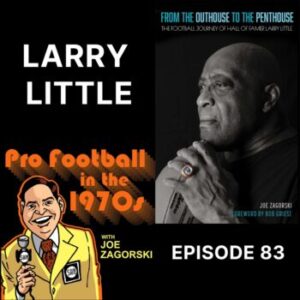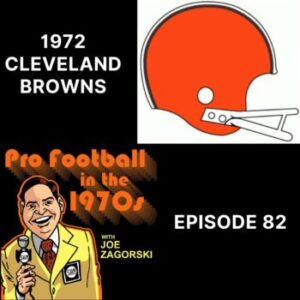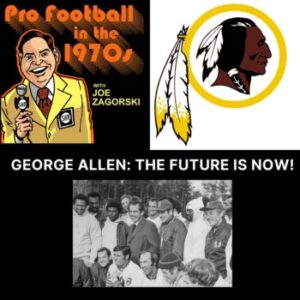Chuck Noll agreed to do one ad during his 23 years as head coach of the Pittsburgh Steelers. A friend of his ran a local bank and Noll allowed his face to be used on a billboard. When he saw it he decided that never again did he want that type of attention. Chuck Noll was all about coaching and teaching the game of football.
Now, eleven years after the passing of the Pro Football Hall of Fame coach, it’s time to look back on the career of one of the best to ever do it.
Coaching was a job Noll excelled at like few others in NFL history. Noll’s Steelers defined an era and reached summits that only legendary teams like George Halas’ Bears, Vince Lombardi’s Packers and Shula’s Dolphins had ever conquered to that time. In 1993 those accomplishments were recognized with Noll’s induction into the Pro Football Hall of Fame.
Noll took the knowledge gained during his playing career from 1953 to 1959 with the Cleveland Browns under Pro Football Hall of Fame Coach Paul Brown and from his nine seasons as an NFL assistant coach, from 1960 to 1965, with Sid Gillman’s Chargers and from 1966 to 1968 with Don Shula and the Baltimore Colts and created a dynasty.

Steelers' History
The Pittsburgh NFL franchise joined the league in 1933 as the Pittsburgh Pirates. In 1940, the team became the Steelers but under either name, they rarely played winning football. Up to the time Noll was hired as head coach in 1969 the team only finished over .500 in seven seasons.
That doesn’t count 1943 when, due to player shortages because of World War II, the Steelers merged with the Philadelphia Eagles. The Steagles finished that season 5-4-1.
After another run of three failed seasons, 1966 to 1968 with a record of 11-28-3, under Bill Austin as head coach, the team decided it was time to try again to find someone that could reverse the culture of losing that the Steelers were mired in.
Dan Rooney’s first choice for the job was Joe Paterno, who had just finished his third season coaching a Penn State team that he had turned into a college football powerhouse. Paterno decided to stay put and turned the Steelers down.
Noll had already made a positive impression on Rooney and came highly recommended by Don Shula. His philosophy of building through the draft while keeping those players in the organization and teaching them the correct way to play meshed with Rooney’s ideas on how to build a winner.
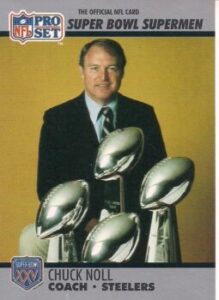
Noll Joins Steelers
On January 27, 1969 the foundation for franchise excellence was set into position. Chuck Noll was hired as the head coach of the Pittsburgh Steelers.
The very next day, in the 1969 NFL Draft, Noll began the building by selecting defensive tackle Joe Greene out of North Texas with the fourth overall pick. Most Steelers fans had been hoping that pick would be Notre Dame quarterback Terry Hanratty. In the Pittsburgh Post-Gazette the following morning the headline read, “Joe who?”
Surprisingly, Hanratty still fell to the Steelers, who selected him in the second round with the 30th overall pick.
There were two other picks from that draft who flew under the radar at the time but were major additions to the emerging dynasty. The first was John Kolb taken in the third round. Kolb anchored Pittsburgh’s offensive line at left tackle for 13 seasons. The second, perennial Pro Bowl defensive end L.C. Greenwood was discovered in the tenth round
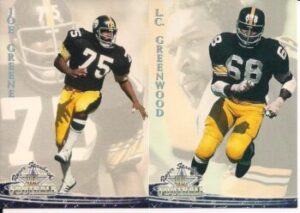
First Season - Two Promises
In Noll’s first meeting at training camp in the summer of 1969 he promised his players two things, that the Steelers’ goal was to win the Super Bowl and that most of them weren’t good enough to be on the team when that happened.
Only five of the players in that room were still playing for Pittsburgh when they went to their first Super Bowl after the 1974 season.
That group proved they weren’t good enough when they finished with a 1-13 record, tied with the Chicago Bears for worst in the NFL. The coin flip to determine the number one choice in the 1970 NFL Draft fell the Steelers’ way and Noll used that pick to select quarterback Terry Bradshaw out of Louisiana Tech.
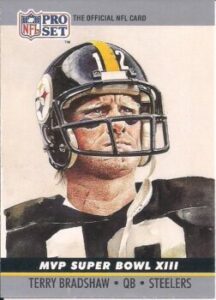
Noll was practically revolutionary in his day, and also would have been in this day, for the way he handled his players. He was not the type who had one rule book in place for each man on the team. He once said, “There are 45 different personalities on a team. How can you deal with each one the same way?” With some players he could show infinite patience. With others he could be painfully, brutally honest
In Andy Russell’s first meeting with Noll he was told, “I’ve been watching game film, Russell, I don’t like the way you play.” He continued, “You’re too aggressive. You’re too out of control. You’re too impatient, trying to be a hero. I’m going to change the way you play.” Russell played another eight seasons and went to six Pro Bowls under Noll.
Contentiuos Relationship
With Bradshaw, the relationship was contentious at the beginning and never really warmed up until both were out of the game years later. Noll leaned hard on Bradshaw, meeting him on the sidelines after every mistake to confront and chew him out. Noll once said, “I always wanted Terry to be a leader, but you can’t just tell someone to go out and lead. You become a leader by doing.”
The result of that trial by fire though was that Bradshaw developed into one of the NFL’s greatest quarterbacks. He was inducted into the Pro Football Hall of Fame in 1989. Bradshaw likely would never have matched his talent and potential results under any other coach.
Noll’s goal was to build teams around quick players who could think while in the middle of the chaos on the field, defying trends of that era. Where teams built their offensive lines with large, tall players he wanted linemen who could react and linebackers who were fast and could drop into coverage when needed.
Steel Curtain
Looking back at the linebackers who were keys to the 1970’s Steel Curtain defenses you can see that team building philosophy in action. Jack Ham was 6 feet, 1 inch tall and weighed 225 pounds. Andy Russell weighed the same at 6 feet, 2 inches of height. In the middle Jack Lambert was taller at 6 feet, 4 inches but lighter at 220 pounds. All 20 to 40 pounds lighter than other linebackers of the time yet they comprised one of the best trios in NFL history.
Noll’s teams were fundamentally sound due to his attention to detail. At each practice the first 30 minutes would be devoted to blocking and tackling. He would teach rookie linemen, whether All-American or on the fringe of the roster how to get into a stance. Opponents not only had to face a physically talented team when they played the Steelers, they also had to face a team that was mentally tough and prepared.


Coach Noll was never one who went in for rah, rah motivational type speeches, except for one notable exception. In 1974 the Oakland Raiders had defeated the defending Super Bowl Champion Miami Dolphins in their divisional round playoff match-up in what has come to be known as the “Sea of Hands” game.
With time running out the Raiders were on the Dolphins’ 8-yard line. With a defensive lineman wrapped around his legs a falling Ken Stabler flipped the ball towards the end zone. Clarence Davis made the catch in the end zone surrounded by three Dolphins defenders to give the Raiders a 28-26 victory.
As told by Joe Greene, the following Monday the Steelers met to review their own playoff win against the Buffalo Bills when Noll slammed his desk and said, “You know, the coach of the Raiders said the two best teams in football played yesterday, and that was the Super Bowl. Well, the Super Bowl is three weeks from now, and the best team in pro football is sitting right here in this room!”
The Steelers scored 21 points in the fourth quarter the following Sunday against Oakland to win the AFC Championship Game 24-13.
Noll was never a coach that worked 18-to-20-hour days during the season while catching sleep on the office coach. He believed football should never be so important that it interfered with family life. He was always home at reasonable hours during the week without bringing his work with him.
His belief in a balanced life showed up in his varied off-field activities. He played ukulele, loved classical music, enjoyed fine wines, golfed, scuba dived and flew his own airplane.
Noll could have kept his name in the forefront with fans with pregame shows or in the broadcast booth like many other coaches have done but he had too much else to do. After retiring he left football completely behind and threw himself into his personal interests.
Hall of Fame Career
During his Pro Football Hall of Fame career Noll compiled a 209-156-1 record. He led the Steelers to 12 postseason appearances and surpassed legends like Bill Walsh, Shula and Tom Landry by becoming the only coach in NFL history to lead his team to four Super Bowls victories. He drafted nine Hall of Fame players including four before the Steelers’ first Super Bowl season of 1974. They were wide receivers Lynn Swann and John Stallworth, middle linebacker Jack Lambert, and center Mike Webster.
In a 2007 profile, Paul Zimmerman of Sports Illustrated wrote that Noll had been recently asked how he wanted to be remembered. Noll’s reply, “A teacher. A person who could adapt to a world of constant change. A person who could adapt to the situation. But most of all a teacher. Put down that I was a teacher.”
Mission accomplished coach!
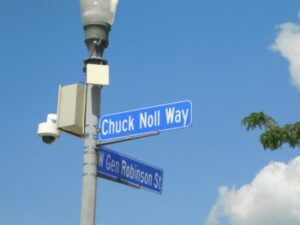
Please Share If You Liked This Article
Please Note – As an Amazon Associate I earn from qualifying purchases
More Posts From Pro Football In The 1970s
Remembering the 1973 Denver Broncos
The 1973 Denver Broncos were indeed a special team. They...
Read MoreExploring the Career of Hall of Fame Offensive Guard Larry Little
As many of you may know, I recently wrote a...
Read MoreRemembering the 1972 Cleveland Browns
How many NFL teams during the 1970s do you remember...
Read MoreThe Future Is Now With George Allen
When George Allen became the new head coach for the...
Read More
